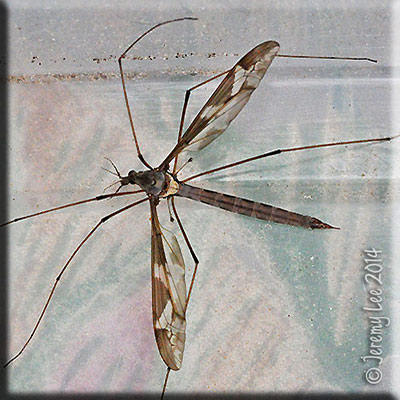
 |
|
Scientific Classifications explained » Amphibians » Ants » Aphids » Bees » Beetles » Birds » Bugs » Butterflies » Caterpillars » Damselflies » Dragonflies » Earwigs » Flies » Frog/Leafhoppers » Fungi » Galls » Grasshoppers » Harvestmen » Hoverflies » Lacewings » Ladybirds » Leaf Mines » Lichens » Mammals » Millipedes » Mosses » Moths » Sawflies » Slugs » Snails » Spiders » Trees & Shrubs » Wasps » Wild Flowers » Woodlice » Postboxes |
UK Nature > Flies > Tipula maxima

Scientific Name: Tipula maxima Common Name: Crane Fly Tipula maxima, a Crane Fly or Daddy Long Legs (in the UK), is the largest of the crane flies found in the UK, measuring anything up to 40-50mm in length and with a leg span of 100mm or more. As with all crane flies, they have very fragile legs, which can easily break off during handling. The male has a swollen tip to his abdomen, but the female (shown here) has a pointed tip which she uses to push her eggs into the soil. Similar to many other flies, their early development is in an aquatic environment. The female will lay her eggs in the damp edges of ponds, ditches and streams. Upon hatching, the larvae then convert to a life underwater, breathing through their tails, which they poke above the surface of the water. Adult flies rarely feed. They are on the wing for most of the year, but most common in autumn when they swarm over our lawns and come to lighted windows at night. They rest with their wings outstretched and are commonly seen on house and garden walls. Common and found throughout the UK. |
|

https://www.uknature.co.uk is a website dedicated to showing the immense diversity of UK nature and wildlife. Our vast range of habitats, from lowland arable to snow covered mountains, from storm-ravaged coastlines to peaceful inland freshwater lakes and rivers, from dry, sandy heaths to deciduous and coniferous forests, all these habitats contribute to the abundance of UK nature. We have wild birds in huge numbers either residing or visiting our shores (597 recorded species as at July 2013) and we must also not forget the humble back garden with its grass lawns, flower beds filled with nectar rich flowers, shrubs and trees, all designed to attract huge numbers of insects such as bees, moths, butterflies and hoverflies; and finally the small ponds which provide safe havens for frogs, toads, newts and even slow worms and grass snakes. www.uknature.co.uk is the showcase for my personal passion, photographing uknature in all its glory. I sincerely hope you all enjoy the fruits of my labours. This site and all images contained therein is © Jeremy Lee 2004 - 2025. All Rights Reserved. Site design by Jeremy Lee. Site development & IT Support by Stuart Lee. |